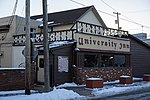Hope Memorial Bridge

The Hope Memorial Bridge (formerly the Lorain–Carnegie Bridge) is a 4,490-foot-long (1,370 m) art deco truss bridge crossing the Cuyahoga River in Cleveland, Ohio. The bridge connects Lorain Avenue on Cleveland's west side and Carnegie Avenue on the east side, terminating just short of Progressive Field. Four pairs of statues designed by sculptor Henry Hering and architect Frank Walker, officially named the Guardians of Traffic, are sculpted onto opposite-facing ends of two pair of pylons, a pair at each end of the viaduct. They symbolize progress in transportation. Each Guardian holds a different vehicle in its hands: a hay wagon, a covered wagon, a stagecoach, and a 1930s-era automobile, as well as four types of motorized trucks used for construction.
Excerpt from the Wikipedia article Hope Memorial Bridge (License: CC BY-SA 3.0, Authors, Images).Hope Memorial Bridge
Ohio & Erie Canal Towpath Trail, Cleveland
Geographical coordinates (GPS) Address Nearby Places Show on map
Geographical coordinates (GPS)
| Latitude | Longitude |
|---|---|
| N 41.489407 ° | E -81.693554 ° |
Address
Hope Memorial Bridge
Ohio & Erie Canal Towpath Trail
44113 Cleveland
Ohio, United States
Open on Google Maps











